×


We have detected your country as:
Please click here to go to the USA website or select another country from the dropdown list.
by: Janet Aslin, Assistant Editor
Recently, our Bridges for Peace family of volunteers spent two fun-filled days exploring a bit of southern Israel. “The Salad Trail,” one of the sites on our itinerary immediately grabbed my attention. I love to hike but adding the word “salad” to the mix left me pondering just what type of trail this might be? I couldn’t wait to find out!
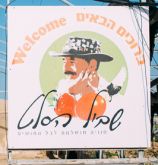 A hidden treasure of an organic farm, the Salad Trail is located in the northern Negev Desert, about 5 miles (8 km) from the Rafah Crossing on the Egyptian border and the same distance from Israel’s border with the Gaza Strip. Its founder, agronomist Uri Alon, had a vision to turn his commercial farm into an educational facility. Every year some 55,000 visitors from Israel and the nations of the world come to taste and see how the sandy, dry soil of the desert is being made to grow delicious vegetables, fruits and herbs.
A hidden treasure of an organic farm, the Salad Trail is located in the northern Negev Desert, about 5 miles (8 km) from the Rafah Crossing on the Egyptian border and the same distance from Israel’s border with the Gaza Strip. Its founder, agronomist Uri Alon, had a vision to turn his commercial farm into an educational facility. Every year some 55,000 visitors from Israel and the nations of the world come to taste and see how the sandy, dry soil of the desert is being made to grow delicious vegetables, fruits and herbs.
Water is the secret ingredient to making the desert bloom. Israel’s innovative drip irrigation system, pioneered in the late 1950s, enables growers to target precise amounts of water to the plants and results in an estimated water savings of 80%. In addition, Israel leads the world in recycling sewage water and that purified water is primarily re-used in agriculture.
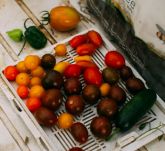 Our first stop was a greenhouse filled with tomato, pepper and cucumber plants. Peter, our guide, carefully explained how they had been able to increase the pollination of their tomatoes from 50% to 100% by training the tomato plants to grow in a U-shape before continuing upward. The farm now achieves an average tomato yield of 28 tons per quarter acre!
Our first stop was a greenhouse filled with tomato, pepper and cucumber plants. Peter, our guide, carefully explained how they had been able to increase the pollination of their tomatoes from 50% to 100% by training the tomato plants to grow in a U-shape before continuing upward. The farm now achieves an average tomato yield of 28 tons per quarter acre!
As we watched, our guide held up eight different varieties of tomatoes and told us something about each one. The “Zebra” actually is striped while the “Chocolito” is a brownish color. He demonstrated the amazing “Sandwich” tomato by cutting it in half and squeezing—when no liquid fell to the ground, it was proof that the “Sandwich” has only 10% of the liquid of a regular tomato.
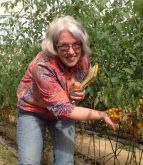
Then we were turned loose to taste! Because no pesticides are used in the greenhouse, it was safe to pick and eat straight from the vine. For an Alaskan, I have to say this was the most amazing part. I never knew tomatoes could have such wonderful and different tastes and qualities. After much sampling, I finally decided my personal favorite was the “Blondie,” a deliciously sweet, thin-skinned, yellow cherry tomato.
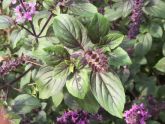
We continued on to the next greenhouse. The farm produces 30 different types of herbs and spices, many from different parts of the world. Nana, or mint, is an Israeli favorite addition to hot tea or lemonade in the summer. There were at least six different mint varieties growing here: English (tastes like spearmint), Spanish, Egyptian (sharp tasting), Moroccan, Israeli and Wild. We tasted two types of basil, regular and lemon-flavored, and a variety of chive that tastes like a blend of garlic and onion. The curry plant yielded its distinctive scent when its leaves were rubbed together.
Many of the plants in the greenhouse had a medicinal value as well. We learned that lavender is a miracle plant that: can cure headaches, help you sleep, is an anti-depressant, cleans wounds and stops bleeding.
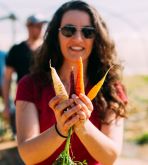 We emerged from the herb greenhouse and sat for a few moments while Peter explained what we would see next, a field that contained carrots and radishes. The carrot originated in Afghanistan and in the beginning was white. We learned that, about 300-350 years ago, through a natural genetic process, orange carrots appeared on the scene. We can thank the Dutch for taking this vegetable all over the world. They chose the orange species over the white because, according to Peter, the royal house of the Netherlands is the House of Orange. Later on, yellow carrots were developed from the Afghanistan stock. There was one more color—purple—in our carrot patch. Peter told me that the purple ones originated in New Zealand. We had fun looking for each color and comparing the tastes.
We emerged from the herb greenhouse and sat for a few moments while Peter explained what we would see next, a field that contained carrots and radishes. The carrot originated in Afghanistan and in the beginning was white. We learned that, about 300-350 years ago, through a natural genetic process, orange carrots appeared on the scene. We can thank the Dutch for taking this vegetable all over the world. They chose the orange species over the white because, according to Peter, the royal house of the Netherlands is the House of Orange. Later on, yellow carrots were developed from the Afghanistan stock. There was one more color—purple—in our carrot patch. Peter told me that the purple ones originated in New Zealand. We had fun looking for each color and comparing the tastes.
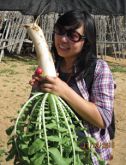 Did I mention there were also radishes in this field? In addition to the round red radish that we are all used to, the field contained a special treat—the daikon, or “big root” in Japanese. According to Wikipedia, the daikon can be 20–35 cm (8–14 in) long and 5–10 cm (2–4 in) in diameter. These were definitely all of that and maybe more, seemingly gigantic when compared with the carrots. Since the daikon is not readily available in the supermarkets here in Israel, several of our Japanese volunteers lovingly packed their harvested treasure for the trip home to Jerusalem and a future culinary treat.
Did I mention there were also radishes in this field? In addition to the round red radish that we are all used to, the field contained a special treat—the daikon, or “big root” in Japanese. According to Wikipedia, the daikon can be 20–35 cm (8–14 in) long and 5–10 cm (2–4 in) in diameter. These were definitely all of that and maybe more, seemingly gigantic when compared with the carrots. Since the daikon is not readily available in the supermarkets here in Israel, several of our Japanese volunteers lovingly packed their harvested treasure for the trip home to Jerusalem and a future culinary treat.
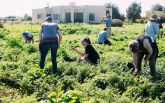 All too quickly it was time to say good-bye. Uri told us there is a Yiddish expression that describes what they are doing—“yiddishe kop”—or literally, the Jewish head. They are always looking for ways to improve the way things are done or to accomplish the impossible, like turning the sandy, dry soil of the desert into a lush and green farm. Sadly, we were limited in the amount of time we could spend at this site so we didn’t get to see everything. We missed the floating strawberries, grown at a height that makes picking easier, pineapples, potatoes and more. I guess that’s just one more reason to schedule a return trip to this amazing hidden treasure in the desert.
All too quickly it was time to say good-bye. Uri told us there is a Yiddish expression that describes what they are doing—“yiddishe kop”—or literally, the Jewish head. They are always looking for ways to improve the way things are done or to accomplish the impossible, like turning the sandy, dry soil of the desert into a lush and green farm. Sadly, we were limited in the amount of time we could spend at this site so we didn’t get to see everything. We missed the floating strawberries, grown at a height that makes picking easier, pineapples, potatoes and more. I guess that’s just one more reason to schedule a return trip to this amazing hidden treasure in the desert.
Photo Credit: Photos by Michio Nagata/Sarah Shank/Cheryl Hauer/Lora Pridgen/bridgesforpeace.com
All logos and trademarks in this site are property of their respective owner. All other materials are property of Bridges for Peace. Copyright © 2025.
Website Site Design by J-Town Internet Services Ltd. - Based in Jerusalem and Serving the World.